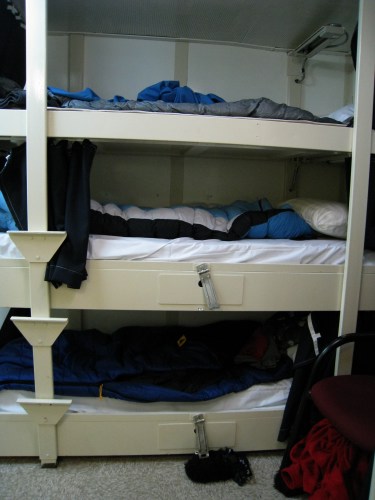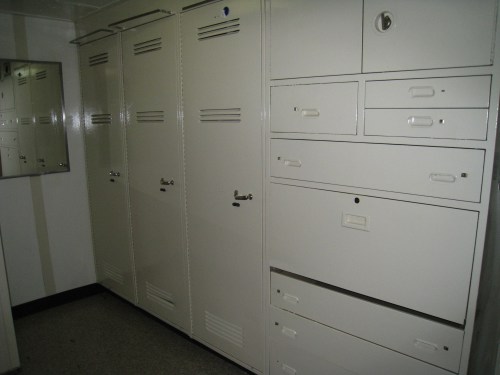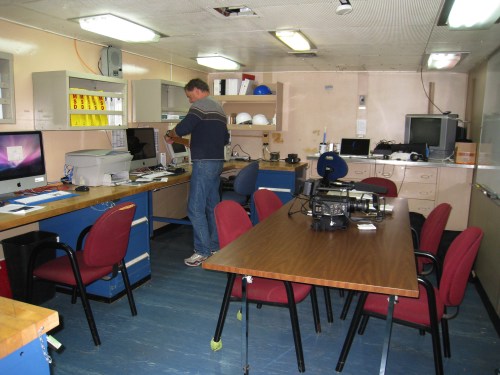Sunrise: 8:43 am Sunset: 7:49 pm
Location:
Lat: 72 degrees 15.24 minutes Long: 155 degrees 02.513 minutes
This morning I woke bright and early, got ready and arrived at a nearly empty mess hall (dining room). I then realized, it's Sunday! On Sunday, there is brunch so people can sleep in a bit later. Since I was already up, I decided to take that time to explore the ship. I figured the best way to learn the layout of the boat was to get lost over and over until I could find my way around. Lucky for me, there are always plenty of helpful Coasties around to help me find my way!
My tour started in the galley (kitchen) and the mess deck(dining area). The food here so far has been great - a full brunch for breakfast of eggs made to order, bacon, sausage, pancakes, and fruit, lunch was chicken sandwiches and salad, and for dinner it was taco night! Also, since it's Sunday, there are sundaes!
 The galley (aka cafeteria) has fed me well so far!
The galley (aka cafeteria) has fed me well so far!
 In the mess hall (dining room) on Sundays there seems to be people relaxing and watching football at most times of the day. It's not normally like that!
In the mess hall (dining room) on Sundays there seems to be people relaxing and watching football at most times of the day. It's not normally like that!
From there, I wondered through the maze of hallways to find the laundry room, the aviation room and the hanger.
 Sunday is laundry day for the scientists.
Sunday is laundry day for the scientists.
 Two helicopters are able to fit inside the hanger if they line up their blades just right.
Two helicopters are able to fit inside the hanger if they line up their blades just right.
 The aviation room is next to the hanger - this is the staging area for all of the gear that we need to take out on the ice.
The aviation room is next to the hanger - this is the staging area for all of the gear that we need to take out on the ice.
To get to all of these places you have to walk up and down many narrow stair cases. My legs have been felling the pain of going up and down what seems like 100 times already!
 The stairwell - they are a bit more like ladders! Despite my clumsiness, I have yet to slip on the stairs!
The stairwell - they are a bit more like ladders! Despite my clumsiness, I have yet to slip on the stairs!
Feeling exhausted from wondering around the ship, I headed back to my room for a bit. There are three of us sharing a room. It's a bit tight, but my roommates are pretty great, so it's not so bad. The hardest part was waking up in the morning and forgetting that I was in the middle bunk and smacking my head!
 Our bunks - mine is the middle one! I have to be really careful not to hit my head.
Our bunks - mine is the middle one! I have to be really careful not to hit my head.
 Ample storage space for all the cold weather gear!
Ample storage space for all the cold weather gear!
Another interesting part of ship life, are the sea showers! Since water is limited while on the boat, we have to make sure to take short showers - the water can only be on while you rinse off. You have to turn it off while shampooing and soaping up.
 Have you taken a sea shower before? Don't worry it doesn't involve cold sea water. This just refers to only turning on the water for a few seconds at a time!
Have you taken a sea shower before? Don't worry it doesn't involve cold sea water. This just refers to only turning on the water for a few seconds at a time!
Right around the corner from my room, is the science library. This is a VERY important room for me - it's where I work on writing all my journals and use internet to send them to you all. :) There are usually other people working in here as well.
 The science library. This is the room where I can send my journals and recieve questions from ask the team.
The science library. This is the room where I can send my journals and recieve questions from ask the team.
Later in the day, I explored other parts of the ship. I ventured up to the bridge to check out the view from up there and got to see my first pieces of sea ice. It was pretty exciting - we even were able to see a walrus lounging on a piece of ice basking in the sun!
 My first up-close look at sea ice!
My first up-close look at sea ice!
 Up on the bridge, Katie and Alex are on the look out for birds and mammals.
Up on the bridge, Katie and Alex are on the look out for birds and mammals.
Some work did also get done today, it was another day of preparations. I learned how to prepare the tranquilizer for darting the polar bears. The drug they use to tranquilize the bears is not harmful to the bears. It just makes them woozy and sleepy so they are knocked out. After I see the darting of the bears in action, I'll report back on more of the details.
Another task I had today, was preparing the sample kits for the bears. While each bear is tranquilized the researchers will be collecting several pieces of data. The tools in these kits are to collect fat, milk, hair and feces from the bears. Other data collection will be happening as well using different tools - such as blood and breath samples.
 Every bear that we work with needs a sample kit. I prepared several of these kits today in preparation for field work.
Every bear that we work with needs a sample kit. I prepared several of these kits today in preparation for field work.
While the Polar Bear team was getting set up, the other scientists were also getting ready to go. The "wet lab" was assembled into work stations for the different groups and the team of divers prepped all their diving gear so they are ready to dive tomorrow if we have the right conditions.
 The wet lab. The other researchers are set up in this lab.
The wet lab. The other researchers are set up in this lab.
The team working on water samples, spent time out on the front of the boat putting together their set-up for their experiment. While it was chilly, it was nice to be outside for awhile today.
 The team from Southern Illinois University are putting together their equipment on the front of the ship.
The team from Southern Illinois University are putting together their equipment on the front of the ship.
I'm amazed at the amount of logistics planning that goes into the experiments. There are so many details to the projects. It seems like a full time job to coordinate everything, but the scientists manage all of that plus their experiments. They have to be very good at COLLABORATING PRODUCTIVE and are also great at EFFECTIVELY MANAGING PROJECTS (hey Spartans - notice the connection to the Leadership Skills here!)
Calling all Impact Students!!!
You think that Jen Weks and I are torturing you with all those conversion problems just to torture you? Well, today I had to use those skills in real life! In fact, the Coastie, I was working with said that she has to convert between meters and inches all the time!
Here's a practice problem for you! In order to figure out the wind chill factor (how cold it is outside due to the feeling of the wind), I need to use a chart that was in mph. BUT the ships instruments all give information in knots. A knot is one nautical mile per hour. Ok, so here's where it gets tricky - one nautical mile is NOT the same as one mile. The conversion factor that we had to work with was 1 nautical mile = 2000 yards.
The boat was traveling at a speed of 16 knots. What was the speed in mph?

